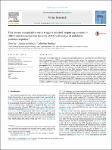Tick-borne encephalitis virus triggers inositol-requiring enzyme 1 (IRE1) and transcription factor 6 (ATF6) pathways of unfolded protein response
Yu, Chao
Achazi, Katharina
Niedrig, Matthias
Tick-borne encephalitis (TBE) is a serious human neurological disease caused by TBE virus (TBEV). However, the mechanisms of TBEV-caused pathogenesis remain unclear. The endoplasmic reticulum (ER) stress response, also defined as the unfolded protein response (UPR), is an important conserved molecular signaling pathway that modulates many biological functions including innate immunity and viral pathogenesis. Here, we investigated the effects of the two UPR signaling pathways upon TBEV infection in Vero E6 cells. We showed that the amount of heat shock protein 72 (Hsp72) increased in the course of TBEV infection. We then confirmed that TBEV infection activates the IRE1 pathway, leading to RNA and protein expression of the spliced X box binding protein 1 (sXBP1). Furthermore, we observed the translocation of ATF6 during TBEV infection and expression of cleaved transcription factor 6 (ATF6) which suggest activation of ATF6 pathway. Finally, we examined whether inhibition of the IRE1 pathway has an effect on TBEV infection. Cell treatment with 3,5-Dibromosalicylaldehyde (IRE1 inhibitor) and tauroursodeoxycholic acid (TUDCA) showed that TBEV replication was significantly limited. These findings provide the first evidence that TBEV infection activates the two UPR signaling pathways. Moreover, inhibition of TBEV replication by UPR inhibitors may provide a novel therapeutic strategy against TBE.
No license information

